ARCHIVED: Chapter 6: Young people in Canada: their health and well-being – Youth Health Risk Behaviours

The use of tobacco, alcohol, and other substances during adolescence is sometimes regarded as non-normative and anti-social. Yet youths' desire for independence and their curiosity to discover the world around them contribute to initial experimental use of tobacco, alcohol, and marijuana. Many do not venture beyond the experimentation phase, but others continue to be involved in a lifestyle that predisposes them to various health risks. Engaging in health risk behaviours is the primary cause of morbidity and mortality of adolescents.
These behaviours tend to occur together in youth, creating a health-compromising lifestyle with consequences for physical health (Pickett, Boyce, Garner, and King, 2002). This chapter explores the health risk behaviour patterns of Canadian adolescents regarding smoking, alcohol, substance use, and sexual activity and examines changes in these behaviours over the past 12 years.
Smoking
Smoking among young people is linked to increased frequency and severity of respiratory illnesses, decreased rate of lung growth and lung capacity, and higher resting heart rates that affect physical performance and endurance. Smoking is also a marker for alcohol and substance use and is associated with early sexual activity and engagement in unprotected sex (Centers for Disease Control and Prevention, 1993). In the 2002 HBSC survey, daily smoking among youth was at its highest rate in Grade 10 (Figure 6.1). Since the 1998 survey, the rates of smoking for young Canadians have remained steady, except for Grade 8 boys and girls, which have decreased slightly, and for Grade 10 girls, which have dropped considerably (Figures 6.2 and 6.3). Data from Statistics Canada indicate that in the past, smoking prevalence has been higher for girls between the ages of 15 to 19 than for boys of the same age (Health Reports, 1999). This is consistent with findings from the 1990, 1994, and 1998 HBSC surveys. However, in the 2002 HBSC sample - which looks at 12-to 16-year-olds, a slightly younger age group than that of the Statistics Canada sample - 15 percent of Grade 10 boys smoked daily, compared with only 11 percent of girls in the same grade (Figures 6.2 and 6.3). The decline in girls' smoking daily from 21 percent in 1998 to 11 percent in 2002 in Grade 10 represents an important change and was accompanied by decreased occasional smoking (at least once a week, but not every day, and less than once a week) among girls at this age as well.
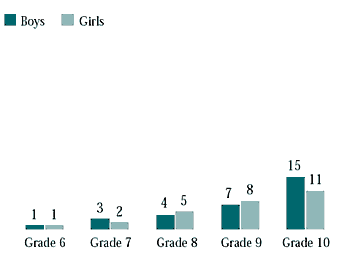
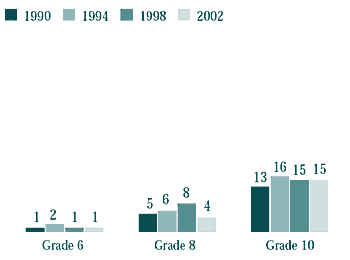
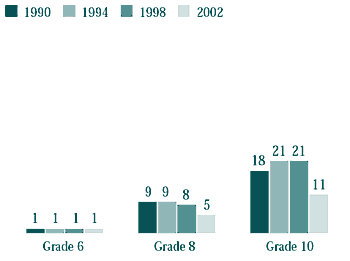
Similar declines in smoking rates among girls have been documented in the United States (Johnston, O'Malley, and Bachman, 2002), where cigarette smoking for girls in Grade 10 dropped from 16.8 percent in 1998 to 11.9 percent in 2001. Higher prices of cigarettes, reduced cigarette advertising, increased media campaigns directed at the harmful effects of smoking, and changing social attitudes toward smoking and smokers may have contributed to this decline (Johnston et al., 2002), although these same factors have not affected smoking rates among boys in Grade 10.
Having a parent who smoked increased the chance an adolescent would smoke. Both boys and girls in Grades 6, 8, and 10 were significantly more likely to smoke if they had a parent who smoked (Figures 6.4 to 6.7).
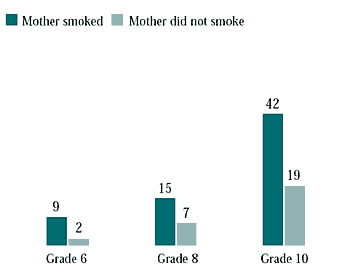

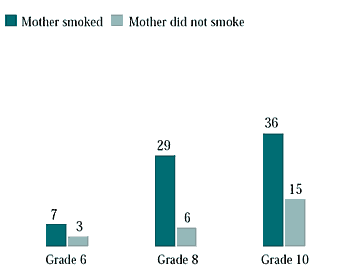
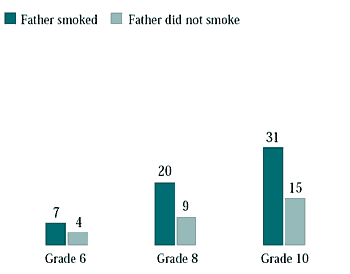
Other studies have found maternal, compared with paternal, smoking to be a stronger determinant of adolescent smoking (Kandel and Wu, 1995; Griffin et al., 1999; Key and Marsh, 2002). This was true only for girls in Grades 8 and 10 in the HBSC sample. In addition, having a best friend who smoked was highly associated with being a smoker for all students in the HBSC surveys (Figures 6.8 and 6.9).

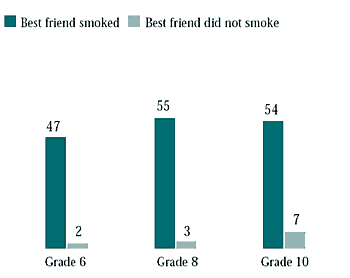
Students who smoke are more likely than their counterparts to experience underlying emotional or psychological problems (Centers for Disease Control and Prevention, 1993) and reduced life satisfaction (Zullig, Valois, Huebner, Oeltmann, and Drane, 2001). Figures 6.10 and 6.11 show that in the HBSC sample, non-smokers, both boys and girls, seemed to be happier with their home lives than were daily smokers.
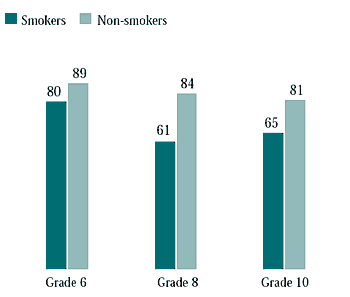

Smoking with friends may become socially functional and symbolic of peer group belonging (Connop and King, 1999). In the HBSC sample, the majority of daily smokers, especially girls, often smoked with friends (Figure 6.12), perhaps indicating a peer support function of smoking.
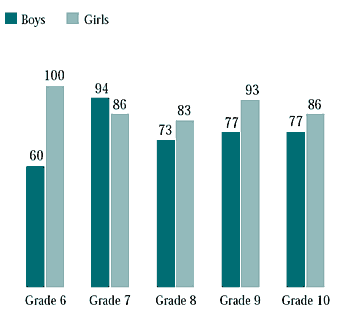
Alcohol
All students surveyed in the 2002 HBSC study were below the legal age for the purchase and consumption of alcoholic beverages in all jurisdictions in Canada.
Alcohol consumption is one of a cluster of adolescent risk behaviours that tend to occur together. Alcohol use can compromise performance at school and result in psychological impairment, drunk-driving risks, and diminished ability to think clearly and make judgments (Johnston et al., 1998). Adolescents cite five main reasons for drinking alcohol: to have a good time with friends; to experiment and see what it's like; to feel good or high; to experience its taste; and to relax and relieve tension (Johnston et al., 1998).
Among adolescents, alcohol tends to be the substance of choice and is often the first one they try (Andrews, Hops, Ary, Lichtenstein, and Tildesley, 1991; Johnston et al., 1994). Heavy alcohol use is associated with increased smoking and the use of illicit substances over time.
In the 2002 HBSC survey, the rate of weekly alcohol use by youth rose steadily between Grade 6 and Grade 10, from 3 percent to 23 percent for girls and from 6 percent to 34 percent for boys (Figure 6.13).
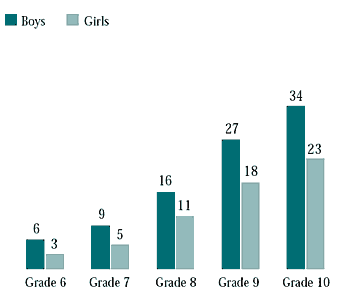
As expected, rates of drinking, particularly of beer and liquor, were substantially higher among students in Grade 10. In 2002, drinking liquor rather than beer or wine appeared to be gaining popularity, especially among younger teenagers (Figures 6.14 to 6.16). This increase may be partly explained by the promotion of sweet-tasting alcoholic beverages such as coolers or “alcopops,” which are especially appealing to girls; the advertising industry capitalizes on appealing images of designer containers for such alcoholic beverages (The National Center on Addiction and Substance Abuse, 2003).
Figure 6.14 Students who drank beer at least once a week, by year of survey (%)

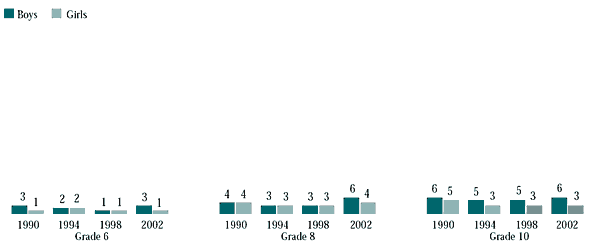
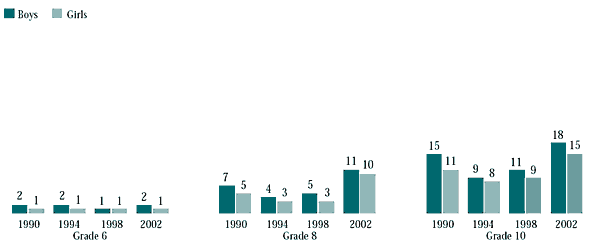
The use of alcohol to get drunk rose sharply by mid-adolescence (Grades 9 and 10). A significant proportion (16 percent) of Grade 8 students reported being really drunk at least twice, and by Grade 9, the proportion was almost one-third (Figure 6.17). Similarly, 44 percent of Grade 10 students reported being drunk at least twice. However, 23 percent of girls and 34 percent of boys in Grade 10 reported drinking alcohol at least once a week (Figure 6.13). This pattern is consistent with other Canadian research which has found that young Canadians drink infrequently but tend to drink excessively when they do (Hewitt, Vinje, and MacNeil, 1995). It is interesting to note that there were no substantial gender differences with respect to getting drunk.
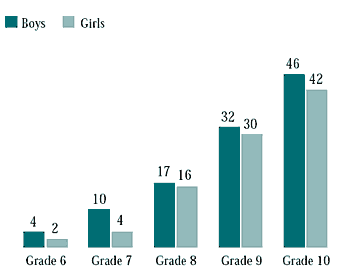
Substance Use
Substance abuse during adolescence may have long-term implications for the well-being of youth and their involvement and contribution to society. It is generally recognized that smoking cigarettes and drinking alcohol precedes the use of marijuana among adolescents; similarly, the use of other drugs like cocaine, heroin, or LSD is almost always preceded by the regular use of marijuana (Tashkin, 1993; Zapert, Snow, and Tebes, 2002). Questions related to the use of drugs were addressed only to students in Grades 9 and 10 of the 2002 HBSC sample.
HBSC data over the past 12 years suggest that experimentation with marijuana has continued to rise for Grade 10 boys (50 percent) but has levelled off for girls (40 percent) (Figure 6.18). Earlier regional studies in Canada indicate that approximately 40 percent of adolescents have tried marijuana by the age of 15 (The McCreary Centre Society, 1999). Some authors suggest that the popularity of marijuana as a social drug among adults is contributing to the availability and acceptance of its use as a safe recreational activity by adolescents (Tonkin, 2002). However, data on the impact of long-term marijuana use on adolescent health are not yet available. Data derived from clinical reports has demonstrated an association between marijuana use and declining performance in school, decreased motivation, and increased absenteeism (Tonkin, 2002). Figures 6.19 and 6.20 show increasing use of marijuana by grade. One-third of boys and one-quarter of girls in Grade 10 had used marijuana three or more times in the past year.
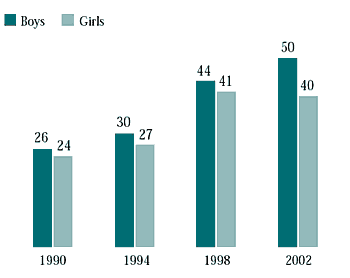
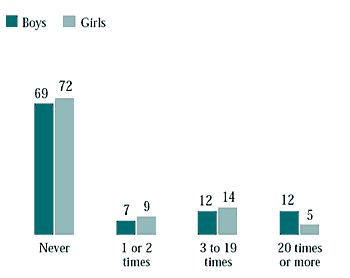
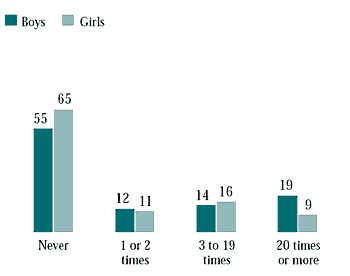
Table 6.1 illustrates the strong relationship between marijuana use and getting drunk, drinking beer, liquor, or spirits, smoking cigarettes, and other psychosocial factors. The use of marijuana was related to having friends who engaged in risk behaviours and also to having unprotected sexual intercourse, which increases the risk for pregnancy and for sexually transmitted diseases (STDs), including HIV/AIDS. The use of marijuana was also moderately associated with having poor relationships with parents, with negative feelings toward school, and with dissatisfaction with life. Other research has shown that students who have started using marijuana are twice as likely to drop out of high school, compared with those who have not (Bray, Zarkin, Ringwalt, and Junfeng, 2000).
Figures 6.21 to 6.30 examine adolescent drug use over the past two HBSC surveys (1998 and 2002). Marginally more boys than girls used drugs. The use of marijuana was much more prevalent than was the use of other drugs, such as LSD, cocaine, and heroin/opium/morphine. However, little change was evident in marijuana use, except among Grade 10 boys, over the two surveys.
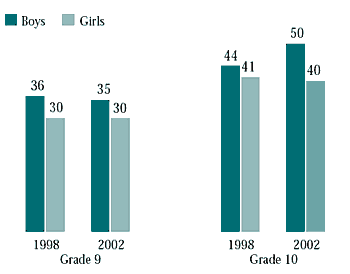

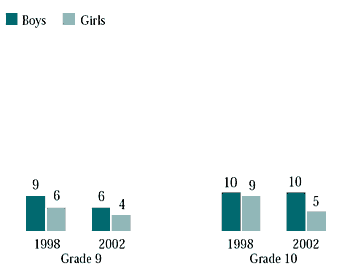
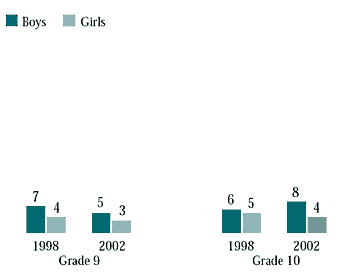

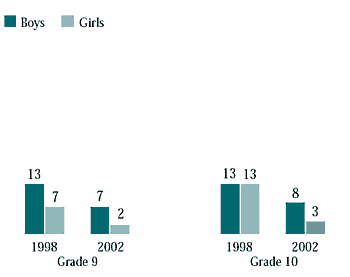
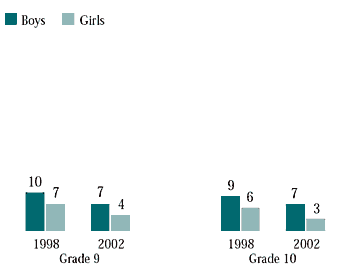
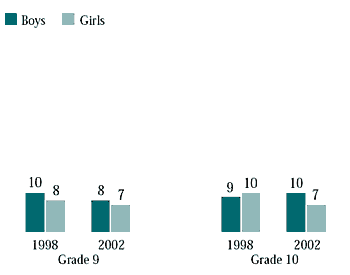


Ecstasy is a synthetic drug with stimulant and hallucinogenic properties that is principally used as a recreational or club drug, especially at raves. The use of Ecstasy in Grade 10 increased only very slightly, by 3 percent for boys and by 2 percent for girls since 1998. Ecstasy use appears to be on the rise in the United States, the United Kingdom, Germany, the Netherlands, and Spain (Community Epidemiology Work Group, 2001).
Amphetamines and cocaine are classified as stimulants that produce a rapid, yet temporary, increase in energy. From 1998 to 2002, amphetamine use decreased by half for Grade 10 girls. Both amphetamine and cocaine use dropped slightly for Grade 9 boys and girls. A significant gender difference was evident in the use of amphetamines and cocaine by Grade 10 students, with twice as many boys using these substances.
The proportion of students who used heroin/opium/morphine remained unchanged from 1998, and fewer girls than boys used this group of drugs.
A downward trend in the use of LSD, a hallucinogen, was apparent from 1998 to 2002. Only half as many boys and a quarter as many girls reported using LSD in 2002. A similar trend in LSD use has been reported among adolescents in the United States (National Institute on Drug Abuse, 2002).
Solvents are present in many office and household products, such as nail polish remover, paint thinner, glue, gasoline, and spray paints. These products are legal, relatively inexpensive, and easy to hide and may be readily available for younger adolescents to get a quick high (Johnston et al., 2001). Inhalants produce an anesthetic effect on the body and a potential loss of consciousness. In addition to damage to the heart, kidney, brain, liver, bone marrow, and other organs, chronic exposure to inhalants results in long-lasting damage to the brain and other parts of the nervous system. Sudden Sniffing Death Syndrome has also been reported as a result of inhalant use (Johns Hopkins Bloomberg School of Public Health, 2001). In the 2002 HBSC survey, the use of glue or solvents dropped slightly, compared with 1998.
Evidence from the United States suggests an increase in the use of prescription drugs for non-medical purposes by adolescents, especially among young girls (National Institute on Drug Abuse, 2001). These drugs include dextro-methorphan (a cough medicine), pain relievers, stimulants such as ephedrine and Ritalin, barbiturates, tranquilizers, and legal narcotics (National Institute on Drug Abuse, 2001). However, in the HBSC surveys, the use of medical drugs by students to get stoned showed little change between 1998 and 2002.
Ritalin is a central nervous system stimulant prescribed to hyperactive children for its calming effect. However, some adolescents take Ritalin as a recreational drug to stay awake, to increase attentiveness, to suppress appetite, and to produce a feeling of euphoria. A question about the use of the drug Ritalin was added to the HBSC survey in 2002. The proportion of students using it to get high was slightly higher for boys across both Grades 9 and 10 (8 percent) than it was for girls (5 percent), as illustrated in Figure 6.29. Other research findings in Atlantic Canada indicate that 8.5 percent of children in Grades 7 to 12 have taken Ritalin for non-medical purposes, compared with 5.3 percent who have been prescribed the drug for medical reasons. Seven percent of children using Ritalin for medical reasons reported having given some of their medication to someone else (Poulin, 2001).
Steroid use has long been popular among male athletes for improving sports performance. However, other studies have also shown an increase in the number of young boys using steroids to enhance their physical appearance (Boston University School of Public Health, 2002). In the HBSC study, anabolic steroids were more popular among boys than girls, but their use remained at low levels and unchanged from 1998 to 2002.
Experimentation with any kind of intoxicating substance during early adolescence increases the likelihood of becoming a heavy smoker later in life (Griffin et al., 1999). In the HBSC study, the sharpest increases in daily smoking and regular drinking occurred between Grades 8 and 10 (Figures 6.1 and 6.13), corresponding with the transition from middle school to high school in many provinces. Table 6.2 shows the association between drunken episodes and smoking for the sample. For instance, 40 percent of Grade 9 and 10 students who had been drunk more than 10 times reported smoking daily, compared with only 1.4 percent of those who had never been drunk.
Sexual Behaviour
Sexual attitudes and behaviours are established during adolescence. It is important to understand and identify risk-taking behaviours that predispose adolescents to pregnancy and sexually transmitted infections, including HIV/AIDS.
Chlamydia and gonorrhea are sexually transmitted bacterial infections, treatable with antibiotics. However, these infections are often asymptomatic in young women. Left untreated, these infections are an important cause of pelvic inflammatory disease and subsequent infertility. The presence of a sexually transmitted bacterial infection also increases the risk of contracting and transmitting HIV (Health Canada, 2002). Of the 32,869 cases of chlamydia reported among Canadian girls in 2000, 40 percent were among young women between 15 and 19 years old. In this age group, the reported rates of chlamydia in girls increased from 1,063 cases per 100,000 in 1998 to 1,236 cases per 100,000 in 2000. Of the 2,368 cases of gonorrhea reported in the same time period, 41 percent were among women between the ages of 15 and 19.
For the 2002 HBSC study, sexual health questions were addressed only to students in Grades 9 and 10. Just under one-fifth of Grade 9 students reported having had sexual intercourse. In Grade 10, approximately one-quarter of students reported having had sexual intercourse (Figure 6.31). These numbers are much lower than those reported in the United States. Data from the National Youth Risk Behavior Study indicate that 36.9 percent of U.S. students in Grade 9 and 66.4 percent of those in Grade 12 reported having had sexual intercourse (American Academy of Pediatrics, 1999). A recent large-scale Canadian study found that among Grade 9 students, 23 percent of boys and 19 percent of girls have had sexual intercourse; and among Grade 11 students, 40 percent of boys and 46 percent of girls have had sexual intercourse (Boyce, Doherty, MacKinnon, and Fortin, 2003).
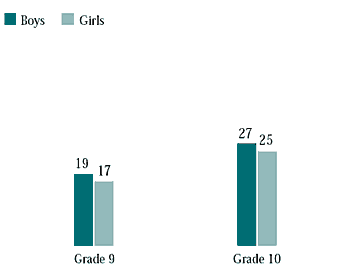
The ability of adolescents to make responsible sexual choices is essential to their development into healthy adults. To estimate adolescent risk-taking practices, students were asked to identify the type of protection/contraception they used the last time they had sexual intercourse (Figures 6.32 and 6.33).
Figure 6.32 Contraceptive measures used by sexually active Grade 9 students the last time they had intercourse (%)

Figure 6.33 Contraceptive measures used by sexually active Grade 10 students the last time they had intercourse (%)
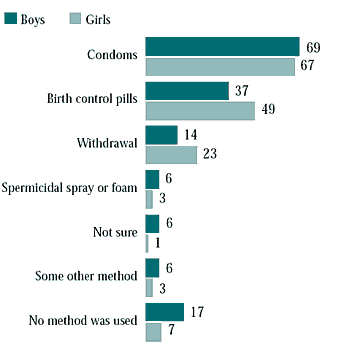

The condom and the birth control pill are reported to be the most commonly used methods of protection and contraception among young women (Polaneczky, 1998). In the HBSC survey, condoms appeared to be the contraceptive measure of choice for both boys and girls. Close to 70 percent of students in both grades and genders reported using condoms the last time they had sexual intercourse. However, the proportion of students who consistently used condoms was not assessed in this study.
Oral contraceptives, when taken regularly, have a 1 percent failure rate in preventing pregnancy. However, the failure rate among adolescents may be as high as 15 percent through inconsistent use, since girls taking birth control pills miss an average of three pills a month (American Academy of Pediatrics, 1999). In addition, oral contraceptives offer no protection against sexually transmitted infections and HIV. In the HBSC sample, girls in Grade 10 reported higher use of birth control pills (49 percent), compared with girls in Grade 9 (41 percent). It is interesting to note that the same proportion of boys and girls in Grade 9 reported the use of birth control pills; this is encouraging because it implies that some boys may be taking responsibility for being informed about the type of contraception used by their partners. However, a lower proportion of boys than girls in Grade 10 stated that they used birth control pills.
Surprisingly, withdrawal appeared to be a common practice among students in both grades, with more girls than boys in both indicating that they relied on withdrawal as a method of contraception the last time they had sexual intercourse (Figure 6.32 and 6.33). This causes concern because of the high failure rate of withdrawal in preventing pregnancy and in providing protection against sexually transmitted infections (American Academy of Pediatrics, 1999).
A small proportion of students (between 1 and 6 percent) in both grades indicated that they were not sure what method they used the last time they had sexual intercourse. However, a significant proportion of boys in both grades (18 percent), and to a lesser extent girls (7 percent), indicated that they had not used any method of protection/contraception the last time they had sexual intercourse.
Sexually active (have had sexual intercourse at least once) and sexually non-active students (have never had sexual intercourse) can be distinguished with respect to adolescent risk behaviours. Between a quarter to a half of sexually active Grade 9 and 10 students smoked every day, compared with less than 6 percent of students who were not yet sexually active (Figure 6.34).
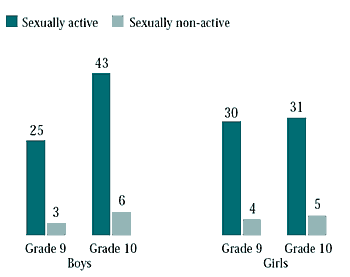
Comparable patterns were evident for the use of marijuana among Grade 9 and 10 students in the sample (Figure 6.35). More sexually active than sexually non-active students in Grades 9 and 10 reported at least moderate marijuana use (more than three times).
Figure 6.35 Sexually active and sexually non-active Grade 9 and 10 students who used marijuana more than three times (%)
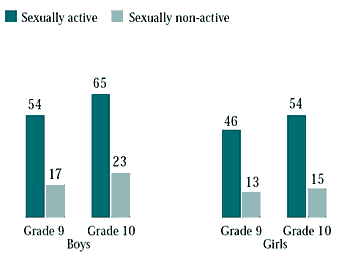
Similarly, more sexually active than sexually non-active boys had been drunk frequently (Figure 6.36). Unplanned sexual intercourse under the influence of alcohol has been associated with inconsistent condom use and having multiple sexual partners (Poulin and Graham, 2001; Boyce et al., 2003). It was apparent in the HBSC sample that a large proportion of sexually active adolescents were at risk of teenage pregnancy and sexually transmitted infections due to excessive alcohol use.
Figure 6.36 Sexually active and sexually non-active Grade 9 and 10 students who had been drunk more than four times (%)
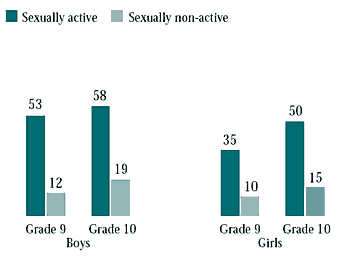
Initiation to Risk
Initiation of health risk behaviours is generally derived from retrospective reports by students. Ages of initiation vary with the age of the sample surveyed, with older students having a larger age span over which they can report initiation. Having alcohol for the first time appeared to occur particularly early in the HBSC study. Peak years for alcohol initiation, especially for girls, were ages 13 and 14 (Figure 6.37). This finding supports adolescent health research which shows that alcohol is the initial substance of choice by adolescents (Duncan, Duncan, and Hops, 1998). Alcohol use is typically regarded as socially acceptable among adults when compared with smoking and drug use and is routinely served with meals at home. In addition, many parents are tolerant of underage drinking at certain social, religious, or cultural events. The peak years for first getting drunk were between 13 and 14, with more girls than boys being drunk for the first time at those ages. A greater proportion of boys had been drunk before age 13 (Figure 6.38).
Figure 6.37 Age that students in Grades 9 and 10 first tried alcohol (%)
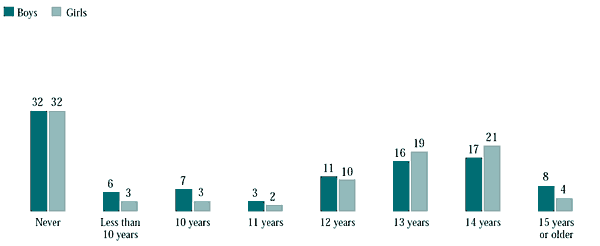
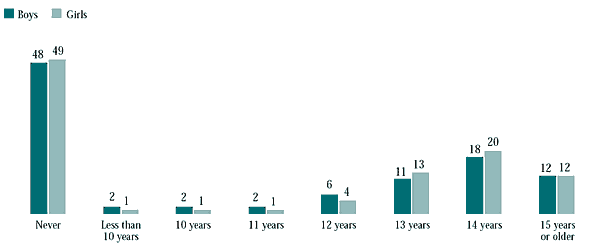
Figure 6.39 illustrates the distribution of age for smoking initiation. About one in 10 students tried smoking cigarettes before the age of 12. Small proportions of both boys and girls experienced sexual intercourse before age 14. However, the vast majority of Grade 9 and 10 students who had experienced sexual intercourse did so when they were 14 years or older (Figure 6.40)
Figure 6.39 Age that students in Grades 9 and 10 first tried smoking (%)
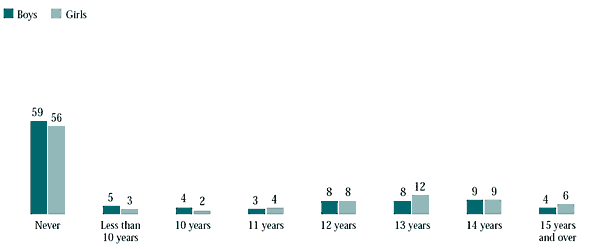
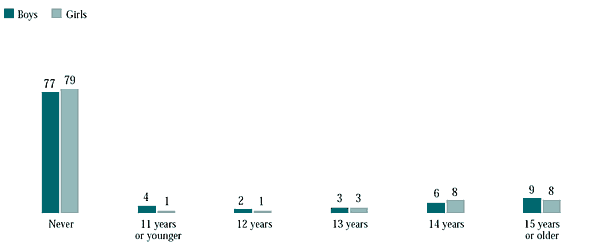
Major Findings

- There was a decrease in smoking in older girls and also in Grade 8 students, by year of survey.
- A slight increase in drinking liquor by younger adolescents was evident, by year of survey.
- Two out of five Grade 10 students reported being drunk at least twice.
- Drug use was fairly stable, except for increased marijuana use in Grade 10 boys and decreased use of LSD for both boys and girls since 1998.
- The use of marijuana was associated with smoking, drinking, sexual risk taking, poor relationships with parents, and negative feelings about school.
- Frequent drunkenness was strongly related to daily smoking.
- Almost 25 percent of Grade 9 and 10 students reported having had sexual intercourse.
- Condom use reported by these students was frequent but not consistent.
- Use of birth control pills was reported to be frequent but not consistent.
- Having had sexual intercourse was associated with daily smoking, marijuana use, and frequent drunkenness.
Page details
- Date modified: